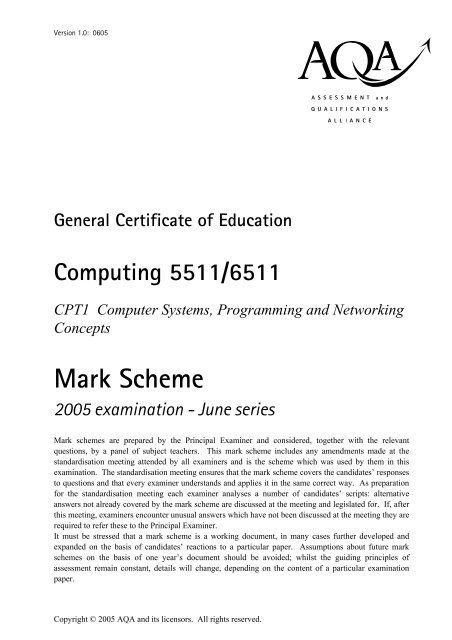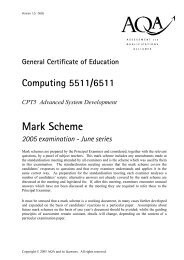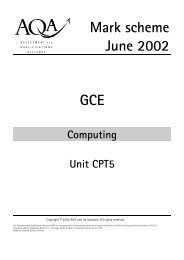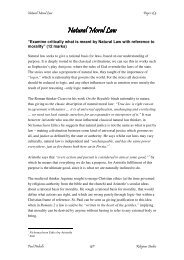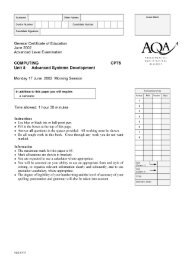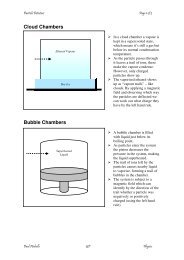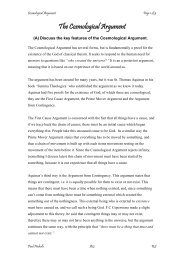AQA GCE Mark Scheme June 2005
AQA GCE Mark Scheme June 2005
AQA GCE Mark Scheme June 2005
Create successful ePaper yourself
Turn your PDF publications into a flip-book with our unique Google optimized e-Paper software.
Version 1.0: 0605<br />
abc<br />
General Certificate of Education<br />
Computing 5511/6511<br />
CPT1 Computer Systems, Programming and Networking<br />
Concepts<br />
<strong>Mark</strong> <strong>Scheme</strong><br />
<strong>2005</strong> examination - <strong>June</strong> series<br />
<strong>Mark</strong> schemes are prepared by the Principal Examiner and considered, together with the relevant<br />
questions, by a panel of subject teachers. This mark scheme includes any amendments made at the<br />
standardisation meeting attended by all examiners and is the scheme which was used by them in this<br />
examination. The standardisation meeting ensures that the mark scheme covers the candidates’ responses<br />
to questions and that every examiner understands and applies it in the same correct way. As preparation<br />
for the standardisation meeting each examiner analyses a number of candidates’ scripts: alternative<br />
answers not already covered by the mark scheme are discussed at the meeting and legislated for. If, after<br />
this meeting, examiners encounter unusual answers which have not been discussed at the meeting they are<br />
required to refer these to the Principal Examiner.<br />
It must be stressed that a mark scheme is a working document, in many cases further developed and<br />
expanded on the basis of candidates’ reactions to a particular paper. Assumptions about future mark<br />
schemes on the basis of one year’s document should be avoided; whilst the guiding principles of<br />
assessment remain constant, details will change, depending on the content of a particular examination<br />
paper.<br />
Copyright © <strong>2005</strong> <strong>AQA</strong> and its licensors. All rights reserved.
CPT1 – <strong>AQA</strong> <strong>GCE</strong> <strong>Mark</strong> <strong>Scheme</strong>, <strong>2005</strong> <strong>June</strong> series<br />
Instructions to examiners<br />
The following forms of notation should be used on candidates' scripts:<br />
• Ticks - To indicate what is accepted as correct or creditworthy, placed in the body of the<br />
answer, and on diagrams;<br />
• Underscoring - To identify errors/irrelevance in written answers;<br />
• Crosses - to indicate a wrong answer;<br />
• Brief comments - placed in at suitable points in the body of the text to amplify the<br />
marking;<br />
• BOD - means benefit of the doubt and is used where the candidate's answer has been<br />
given a mark on the balance of probabilities that the candidate's answer has met the<br />
requirements of the mark scheme even though it could be interpreted differently;<br />
• NE - means not enough and is applied to an answer that falls short of what is required;<br />
• O/S - means outside the mark scheme. The candidate's answer is creditworthy but the<br />
answer does not match any of the answers on the mark scheme for the particular<br />
question. Nevertheless a mark is awarded;<br />
• C/F - means carried forward. This arises when a candidate offers an answer that is not<br />
creditworthy in that part of the question but is creditworthy in a later part of the same<br />
question. The mark is carried forward to the part of the question that is creditworthy;<br />
• C/B - means carried back. This is similar to a carry forward but the mark is carried back<br />
to an earlier part of the question.<br />
• T/O - means talked out. The candidate's answer is contradictory.<br />
• F/T - means followed through. If the candidate made a mistake in the earlier part of an<br />
answer, mark the answer using the correct method on their answer from the earlier part.<br />
The following notation is used in the mark scheme<br />
• ; - means a single mark;<br />
• A - means an acceptable creditworthy answer;<br />
• R - means reject answer as not creditworthy.<br />
• I - ignore<br />
• / - means alternative word or sub-phrase<br />
• / / - means alternative answer<br />
2
<strong>AQA</strong> <strong>GCE</strong> <strong>Mark</strong> <strong>Scheme</strong>, <strong>2005</strong> <strong>June</strong> series – CPT1<br />
1. (a) operating system;<br />
utility program (or an example of one);<br />
library program;<br />
compiler/assembler/interpreter/translator;<br />
driver;<br />
user interface;<br />
A BIOS R Any programming language 3<br />
(b)<br />
Payroll;<br />
Stock Control;<br />
Production control;<br />
Sales;<br />
Invoicing;<br />
Word processing;<br />
Spreadsheet;<br />
Database;<br />
Desk top publishing;<br />
Browser;<br />
Or any appropriate application<br />
R e-commerce NE 3<br />
Total 6<br />
2. (a) (i) 0 0 1 1 0 0 1 0 0 0 1 1 0 1 1 1 1<br />
(ii) 0 0 0 0 0 0 0 0 0 0 1 0 0 1 1 1 1<br />
(iii) 0 0 0 0 0 0 0 0 0 0 0 1 1 0 1 1 1<br />
(b) Unicode is 16 bit code; 1<br />
(c) 1 0 0 1 1 0 0 1 1 0 0 1 1 0 0 1<br />
1 1 1 1 1 1 1 1 1 1 1 1 1 1 1 1 2<br />
Total 6<br />
3
CPT1 – <strong>AQA</strong> <strong>GCE</strong> <strong>Mark</strong> <strong>Scheme</strong>, <strong>2005</strong> <strong>June</strong> series<br />
3. (a)<br />
1<br />
Processor<br />
3<br />
6 8<br />
4<br />
5 9<br />
2<br />
7 10<br />
1 mark each for 1, 2, 3, 4.<br />
1 mark for both 5 & 9<br />
1 mark for both 7 & 10 6<br />
(b)<br />
Machine code instructions/program stored in main memory; A RAM/IAS<br />
Can be replaced by another program at any time;<br />
A Fetched and executed; (concept) 1<br />
Total<br />
7<br />
4. (a) (i) Analogue to Digital Converter;<br />
A sound card A A-D Converter A ADC<br />
R MIDI<br />
1<br />
(ii)<br />
Microphone generates analogue signals;<br />
Computer/System requires digital/binary/discrete signals//<br />
Computer/System stores/processes sound in digital/binary form;<br />
2<br />
(b)<br />
(c)<br />
2 – Digital to Analogue Converter; A D-A Converter A DAC<br />
A Sound card (but not if given in (a) (i))<br />
3 – Speaker/ headphones;<br />
Sound wave is recorded/sampled at regular intervals;<br />
Height/Amplitude/Height/Value of sound wave is represented by a<br />
number/binary code/binary pattern;<br />
2<br />
2<br />
4
<strong>AQA</strong> <strong>GCE</strong> <strong>Mark</strong> <strong>Scheme</strong>, <strong>2005</strong> <strong>June</strong> series – CPT1<br />
(d) Number of bits used to store each value//<br />
range of values/numbers/binary codes/binary patterns;<br />
Sampling rate// frequency of sampling // time between samples/values;<br />
R Quality of equipment 2<br />
Total 9<br />
5. (a) (i) Name: Start Bit;<br />
Purpose: Synchronise receiver; 2<br />
(ii) Name: Parity Bit;<br />
Purpose: Perform parity check// check for errors in transmission;<br />
A Prevent errors 2<br />
(iii) Name: Stop Bit;<br />
Purpose: Allow start bit to be recognised// Allow receiver to process<br />
received bits;<br />
A Indicates end of data 2<br />
(b) (i) the number of signal/voltage changes per second;<br />
A rate at which signals are sent; A rate at which voltage changes; 1<br />
(ii)<br />
number of bits per second / unit of time;<br />
R the rate at which bits are sent (question paraphrased) 1<br />
(iii) Range of frequencies a channel can handle;<br />
A maximum line speed; A maximum transmission speed; 1<br />
(c)<br />
A signal can contain one or more bits;<br />
Bit rate can be higher than baud rate;<br />
bit rate = baud rate * number of bits per signal change;; 2<br />
Total 11<br />
6. (a) (i) Name// Hours// RateofPay; 1<br />
(ii) Total; 1<br />
(b)<br />
(c)<br />
Do not use any global variables// use only local variables and/or<br />
parameters;<br />
A Can be compiled independently // can be placed in a library 1<br />
Local and global variables with the same name can be misidentified//<br />
difficult to test individual procedures/ functions//<br />
Not clear that as a side-effect of executing procedure/function a global<br />
variable could change its value; 1<br />
7. (a) (i) First In First Out; or by description<br />
Total 4<br />
(ii) Last In First Out; or by description<br />
2<br />
5
CPT1 – <strong>AQA</strong> <strong>GCE</strong> <strong>Mark</strong> <strong>Scheme</strong>, <strong>2005</strong> <strong>June</strong> series<br />
(b)<br />
FIFO<br />
LIFO<br />
Queue !<br />
Stack !<br />
2<br />
(c)<br />
Reverse the contents of a queue/list;<br />
Push all contents of queue/list onto stack then pop them off into a new<br />
queue/list;<br />
Procedure/function calls;<br />
Local variables;<br />
Parameters;<br />
Return Address;<br />
Volatile environment; A register contents<br />
State 1 Describe 1 2<br />
(d)<br />
list of elements inserted into tree;<br />
to allow rapid/fast searching of the data;<br />
to output sorted/ordered data;<br />
2<br />
Total 8<br />
8. (a) (i) world-wide collection of networks/computers using TCP/IP;<br />
world wide collection of networks/ gateways/ servers/ computers using a<br />
common set of telecommunications protocols to link them together;<br />
world-wide collection of networks/ computers using the same protocol;<br />
world-wide collection of networks/computers using a standard protocol; 1<br />
(ii)<br />
collection of servers using Hypertext Transfer Protocol/HTTP//<br />
collection of data files/ documents using Hypertext <strong>Mark</strong>-up Language/<br />
HTML/ XHTML/ XML; 1<br />
(iii) computers connected within a small geographical area/building/site;<br />
A computers connected using local area network/LAN protocols; 1<br />
(iv) computers connected over a large geographical area;<br />
A computers connected using wide area network/WAN protocols; 1<br />
(v)<br />
Network providing Internet facilities within an organisation/<br />
LAN using Internet protocol; 1<br />
(b) (i) any valid domain name, e.g. aqa.ac.uk; R www.aqa.ac.uk 1<br />
(ii) any valid address in the range 0.0.0.0 to 255.255.255.255; 1<br />
Total 7<br />
6
<strong>AQA</strong> <strong>GCE</strong> <strong>Mark</strong> <strong>Scheme</strong>, <strong>2005</strong> <strong>June</strong> series – CPT1<br />
9. (a) 1 mark for each correct entry 6<br />
New Last Ptr<br />
Values<br />
[1] [2] [3] [4] [5]<br />
max 6<br />
6 3 1 4 7 9<br />
max 1<br />
2<br />
2 9<br />
Total 7<br />
Grand Total 65<br />
1 7<br />
6<br />
(b) Insert 6/a value into the array/ in the correct position; 1<br />
Total 7<br />
Grand Total 65<br />
7


